Burnout Crisis: You OK Tak?
Diterbitkan pada 27 Sep 2025
6 min baca
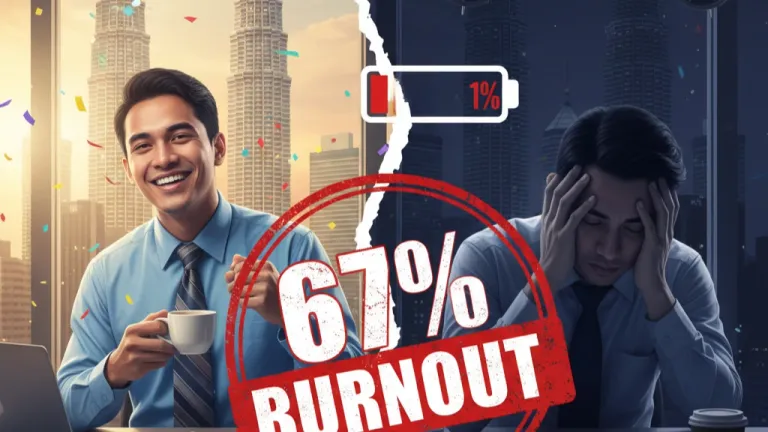
67% Profesional Malaysia Mengalami Burnout.
Awak Salah Seorang?
Hari Isnin pagi.
Dia bangun.
Tekan snooze button tiga kali.
Akhirnya bangun dengan perasaan dread.
Mandi.
Sarapan separuh hati.
Drive ke office dengan anxiety yang tak boleh explain.
Duduk depan computer.
Stare at screen.
Nothing.
Balik rumah jam 9 malam.
Exhausted tapi tak boleh tidur.
Scroll phone sampai 2 pagi.
Repeat.
Sound familiar?
Kalau yes, awak mungkin sedang experience burnout.
Dan awak bukan sorang.
Stats yang shocking:
• 67% pekerja Malaysia burnout pada 2024
• 73% pekerja Singapore experience weekly work stress
• Risk untuk major depression naik 6.48 kali
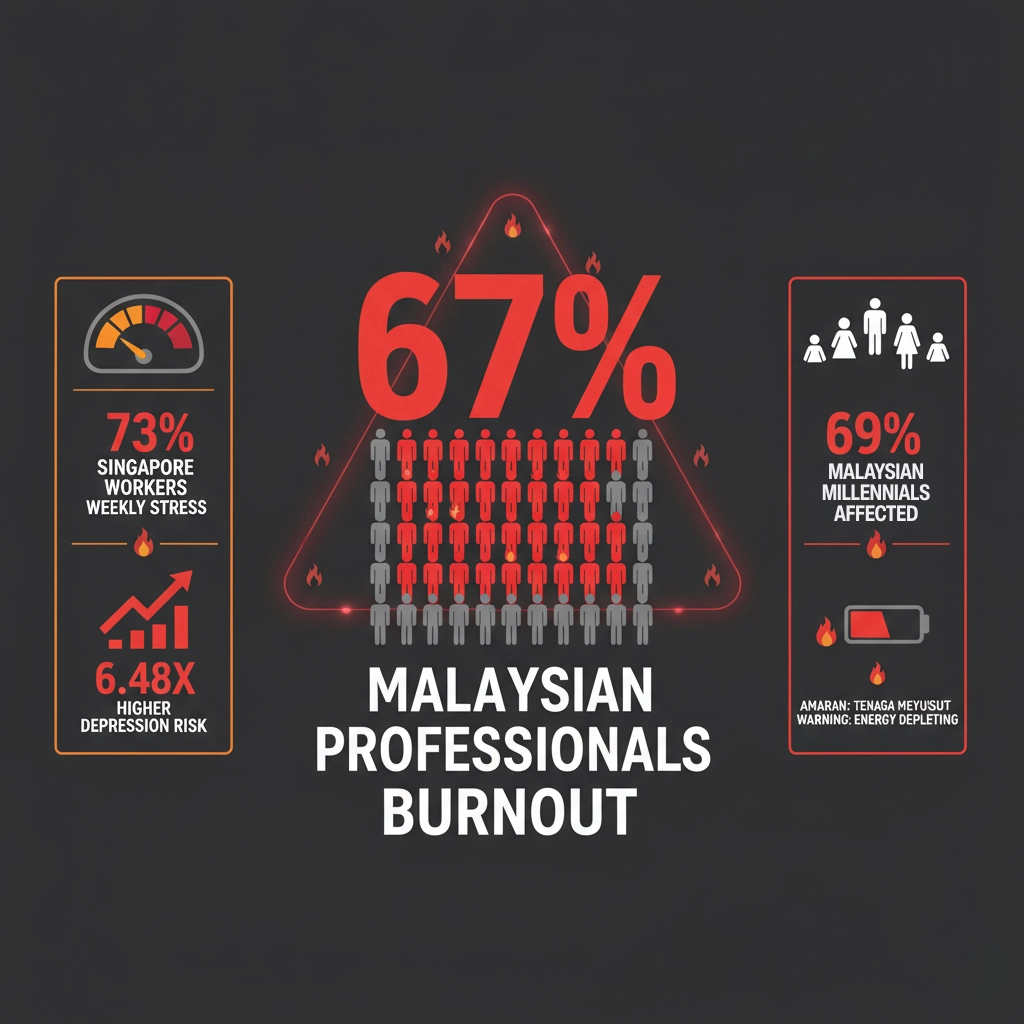
Ini bukan “normal workplace stress.”
Ini epidemic.
Dan ia boleh dicegah.
Apa Sebenarnya Burnout?
Forget everything yang awak fikir tahu tentang “penat kerja.”
Burnout bukan tired lepas overtime.
Burnout bukan Monday blues.
Burnout bukan sekadar stress.
Burnout adalah keletihan emosi yang completely drain seseorang.
WHO define dengan tiga symptoms:
1. Energy habis total
Macam battery phone yang rosak, charge pun tak boleh penuh
2. Cynical terhadap kerja
Everything feels pointless, meaningless
3. Feel incompetent
Rasa macam tak mampu buat anything right
Dan ini yang menakutkan:
Burnout adalah gateway kepada serious mental illness.
10 Warning Signs Yang Ramai Miss
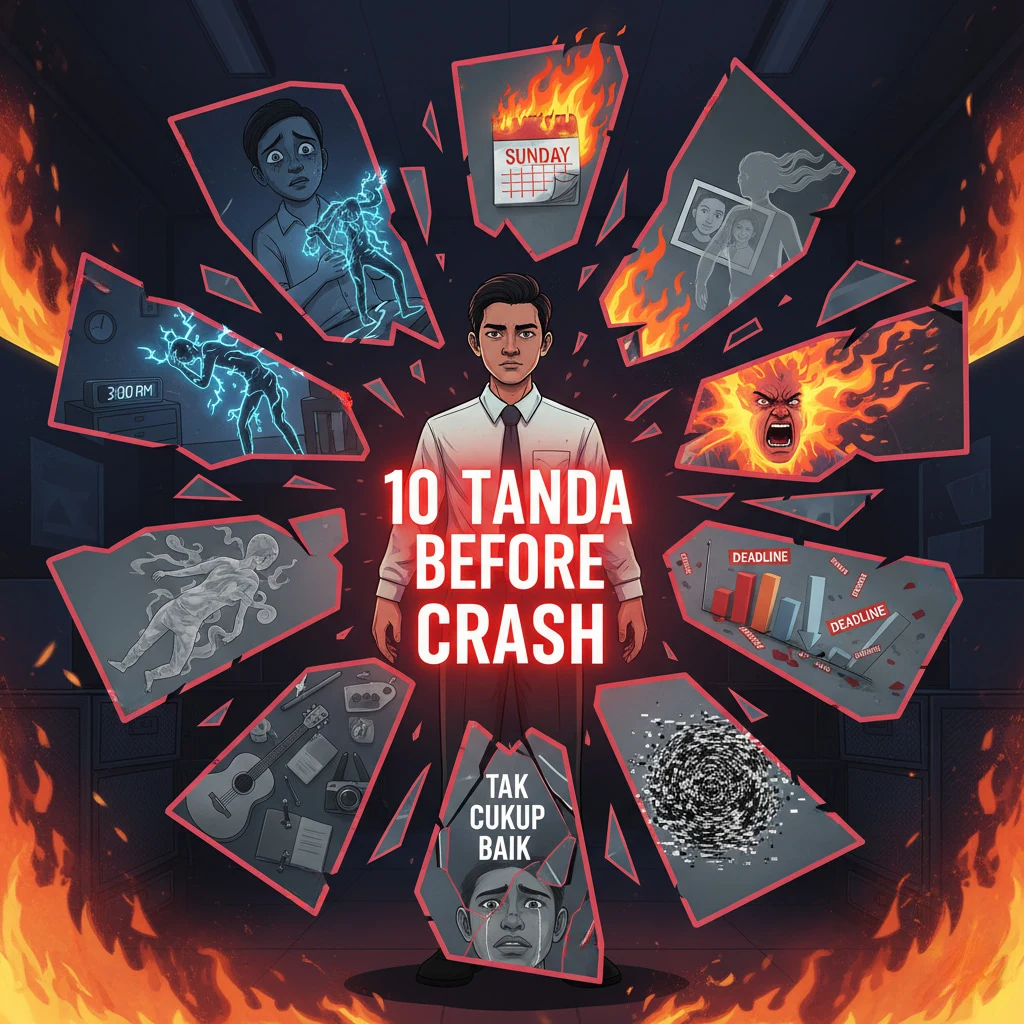
Physical Signs Yang Obvious
1. Sleep Pattern Chaos
• Tossing and turning thinking about work
• Atau tidur excessive untuk escape reality
• Wake up tired even after 8 hours sleep
2. Body Rebels Tanpa Sebab
• Frequent headaches
• Muscle tension yang constant
• Stomach issues, back pain
• Medical check normal, tapi body masih sakit
3. Emotional Exhaustion
• Bangun dah feel drained
• Weekend rest pun tak restore energy
• Feel like emotional zombie
Behavioral Red Flags
4. Hilang Minat Total
Term yang familiar dalam culture kita.
Dulu passionate about projects.
Sekarang everything feels like burden.
5. Social Withdrawal Mode
• Skip team lunches
• Avoid after-work activities
• Prefer hibernate at home
6. Anger Issues
• Snap at colleagues over small things
• Road rage incidents increase
• Family kena tempias frustration
Work Performance Crash
7. Productivity Nosedive
• 2-hour tasks take full day
• Miss deadlines yang dulu easy to meet
• Careless mistakes jadi frequent
8. Focus Completely Gone
• Stare at computer screen tapi nothing productive
• Mind wanders during important meetings
• Can’t complete simple tasks
Psychological Symptoms
9. “Tak Cukup Baik” Syndrome
Constant feeling of inadequacy.
Compare dengan orang lain and always come up short.
10. Sunday Scaries
Dread feeling yang start Saturday night thinking about Monday.
Perut churn every weekend.
Kenapa Generation Kita Kena Teruk?
69% millennials Malaysia experience burnout.
Triple whammy yang attack young professionals:
Workplace Culture Yang Toxic
• Kerja lebih 50 jam seminggu tingkatkan risiko burnout 38%
• “Face time” culture - staying late = dedication
• Hierarchical system yang suppress communication
• 49% pekerja rasa company tak cukup bantu dengan kos hidup yang naik
• Bosses yang tak appreciate effort
Economic Pressure Yang Brutal
• Living costs naik but salary stagnant
• Housing prices “severely unaffordable”
• 17.6% graduate unemployment rate
• Financial stress yang constant
Family Expectations
• Pressure untuk succeed professionally
• Support parents financially
• Social media comparison trap
• Traditional vs modern values conflict
Result?
Perfect storm untuk burnout.
Bila Perlu Panic?
Yellow Alert: 3-4 signs
Orange Alert: 5-7 signs
Red Alert: 8+ signs - seek help immediately
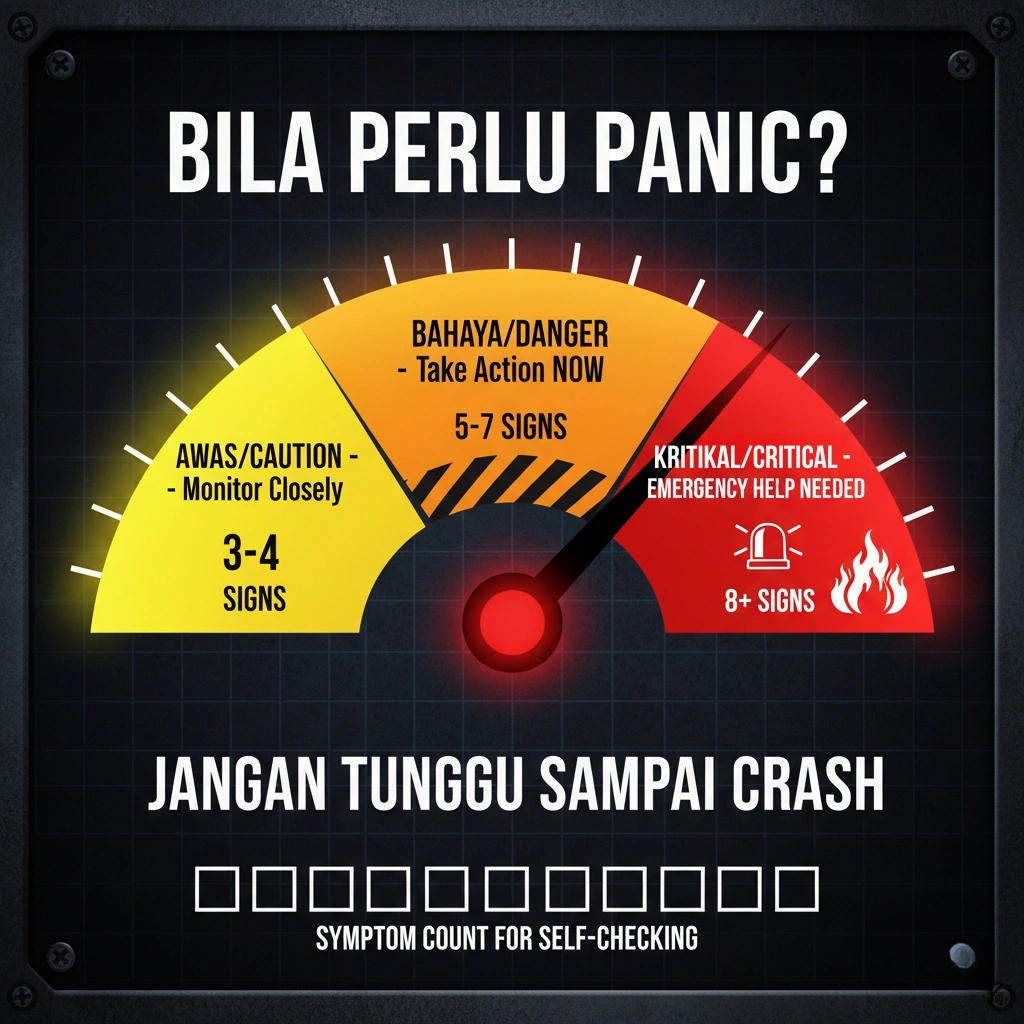
Jangan tunggi sampai crash completely.
Burnout progression is predictable:
-
Honeymoon phase (still motivated)
-
Stagnation (enthusiasm drops)
-
Burnout symptoms appear
-
Complete breakdown
Most people tunggu sampai stage 4.
By then, recovery takes months or years.
Early intervention = faster recovery.
Action Plan: Apa Boleh Buat Sekarang
Immediate Steps (This Week)
Day 1-2: Acknowledge Reality
• Admit yang ada issue
• Stop justifying dengan “everyone stress jugak”
• Rate symptoms 1-10
Day 3-4: Document Patterns
• Track energy levels hourly
• Note trigger situations
• Identify worst times of day
Day 5-7: Reach Out
• Call support hotlines
• Talk to trusted friend/family
• Research professional help options
Get Professional Help
Malaysia:
• HEAL Crisis Helpline: 15555 (8am-12am daily)
• Malaysian Mental Health Association: www.mmha.org.my
• mySalam insurance covers mental health
Singapore:
• Youth Integrated Team (12-25 years): Free assessment
• Care Corner INSIGHT (13-25 years): 6978 4217
Brunei:
• Talian Harapan: 145
• Community Psychology via clinic referral
Set Boundaries At Work
Week 1:
• No emails after 7pm
• Take actual lunch breaks
• Delegate non-essential tasks
Week 2-4:
• Have honest conversation with boss
• Request workload review
• Explore flexible arrangements
Month 2-3:
• Evaluate career path
• Consider job change if necessary
• Build exit strategy
Recovery Tak Bermakna Weak
Biggest myth:
“Strong people don’t get burnout.”
Truth:
Smart people recognize early signs and take action.
Athletes rest between training.
Phones need charging.
Cars need servicing.
Humans need recovery too.
Seeking help bukan sign of failure.
Ia sign of self-awareness and courage.
Companies yang support mental health retain better talent.
People yang prioritize wellbeing perform better long-term.
Warning Signs Dalam Different Industries
Tech/Startup
• Coding quality drops
• Miss obvious bugs
• Can’t learn new technologies
Sales/Marketing
• Client relationships suffer
• Miss targets consistently
• Lose competitive edge
Finance/Banking
• Calculation errors increase
• Risk assessment becomes poor
• Compliance issues arise
Healthcare/Education
• Patient/student care quality drops
• Professional empathy depletes
• Ethical decision-making compromised
Every industry has specific burnout manifestations.
Bila Kawan/Family Member Show Signs
Jangan say:
• “Just think positive”
• “Others have it worse”
• “Take a vacation”
• “Maybe change job”
Instead, try:
• “I notice you seem different lately”
• “Want to talk about what’s happening?”
• “How can I support you?”
• “Professional help might be useful”
Listen without trying to fix.
Validate their experience.
Offer practical support.
Long-Term Prevention Strategy
Build Resilience Habits
Daily:
• 10-minute meditation or breathing
• Physical activity (even walking)
• Limit news/social media
Weekly:
• Complete digital detox day
• Social connection with friends
• Hobby atau creative activity
Monthly:
• Evaluate work-life balance
• Assess career satisfaction
• Professional development yang meaningful
Career Decisions
Red flags untuk avoid:
• Companies dengan high turnover
• Bosses yang micromanage
• Cultures yang glorify overwork
• No growth opportunities
Green flags untuk cari:
• Mental health support programs
• Flexible work arrangements
• Recognition and appreciation culture
• Clear progression paths
Reality Check: Recovery Timeline
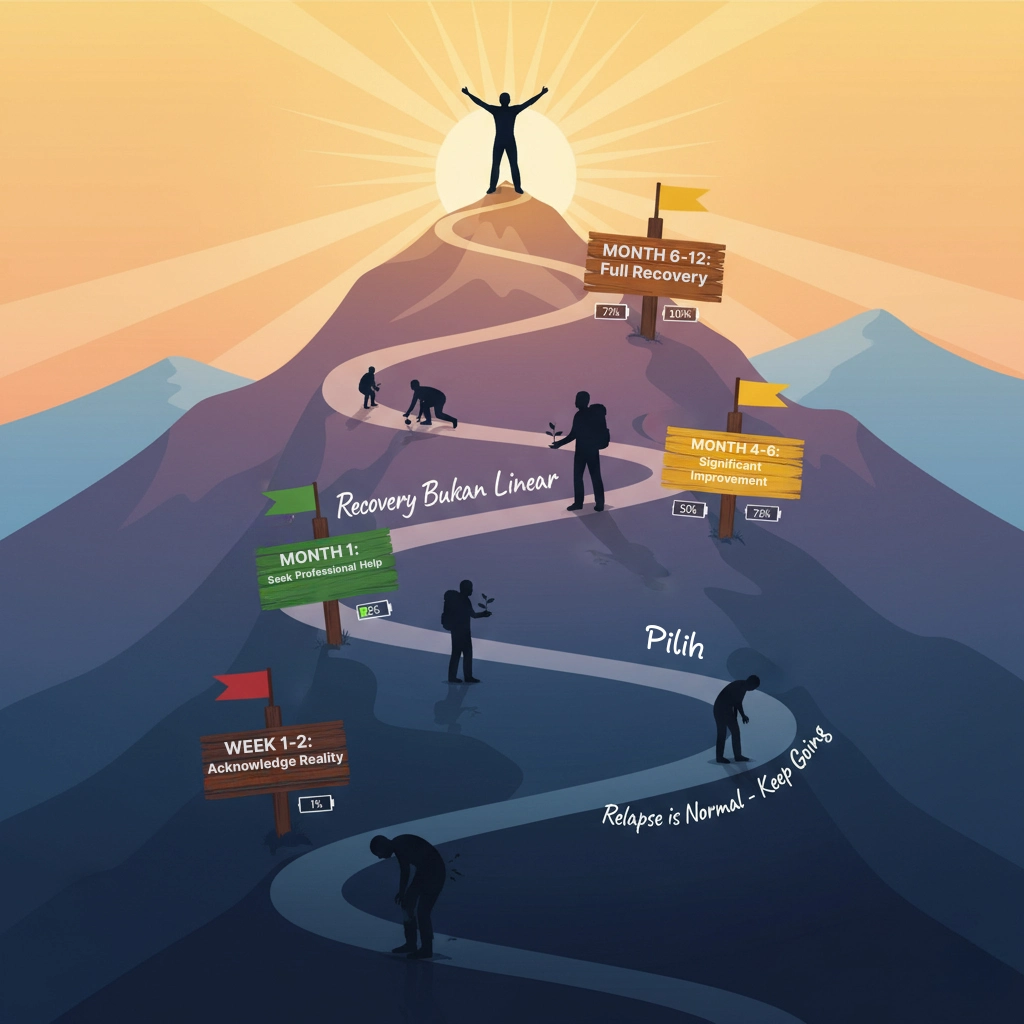
Week 1-2:
Acknowledgment and assessment
Month 1:
Professional help and boundary setting
Month 2-3:
Lifestyle changes and habit building
Month 4-6:
Significant improvement in symptoms
Month 6-12:
Full recovery and prevention habits
Some people recover faster, others take longer.
Key adalah consistent effort, bukan speed.
Relapses are normal during recovery.
Final Truth
Burnout epidemic dalam region kita adalah real.
Majority young professionals affected.
Tapi ia bukan permanent condition.
Recovery adalah possible.
Help is available.
You deserve better than just surviving.
First step:
Recognize the signs.
Second step:
Take action.
Third step:
Be patient with recovery process.
Your mental health matters more than any deadline.
Your wellbeing is more important than any promotion.
Your life has value beyond productivity.
Kalau article ini resonates, share dengan someone who might need it.
Sometimes knowing yang others understand the struggle boleh be life-changing.
Recovery starts with awareness.
Prevention starts with education.
Change starts with one person taking action.
That person could be you.
Emergency: Jika ada thoughts of self-harm, contact crisis helplines immediately atau pergi emergency department terdekat.